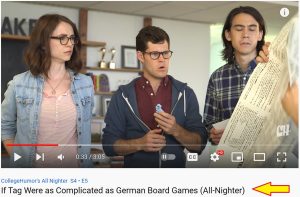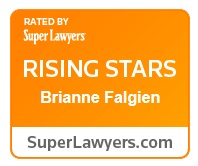Think for a moment about one of your favorite teachers. What qualities made them so good?
We’ll get back to that, but for now I want to share some background about how I came to writing about this subject. As with many things for me, it originated around board games, although it applies to any setting where learning is present.
 In hobby gaming, it often seems like one or two people in a gaming group do most of the teaching. I am definitely one of those people; in 2021 I personally played 95 new games, and without exaggeration, I’m guessing I was probably responsible for learning and teaching over 90 of those. Some of them have been simple; a single, large page of rules. Others have been dense, filled with the dry writing of a textbook and well over 50 pages long. That screenshot is from a hilarious video, linked here, and can be seen anywhere I teach games.
In hobby gaming, it often seems like one or two people in a gaming group do most of the teaching. I am definitely one of those people; in 2021 I personally played 95 new games, and without exaggeration, I’m guessing I was probably responsible for learning and teaching over 90 of those. Some of them have been simple; a single, large page of rules. Others have been dense, filled with the dry writing of a textbook and well over 50 pages long. That screenshot is from a hilarious video, linked here, and can be seen anywhere I teach games.
I don’t mind learning on my own though, because it allows me to digest the information quietly and at a comfortable pace. I can reread something, look up videos to process in the information in a different way, setup the pieces on a table and physically go through the motions, etc. Eventually, I reach that magical tipping point of understanding and can see how the recipe of game mechanics comes together into cohesive experience.

Me trying to understand the rules when someone else is teaching them
However, even though I play hundreds of games a year and have decades of experience in the hobby, I still struggle a bit going into a game blindly and learning from someone else. It’s almost like I have a mind-blocking anxiety built around the small group dynamic and time crunch of processing all this new information so we can start playing. That’s despite the fact I already know most the terms of art, genres, and game mechanics. And if I struggle in that environment, you can only imagine what it’s like for a “non-gamer” learning a new game with any amount of complexity.
So how can I as a learner and a teacher improve the way in which information is delivered?
Cognitive Load Theory
Developed in the late 80’s, Cognitive Load Theory (CLT) is essentially the idea that the brain is limited in its ability to processes new information in various ways, so we should therefore tailor our teaching to accommodate those restrictions.
John Sweller, an Australian educational psychologist, developed the idea. Basically, since the brain has limited short-term memory, teaching should focus on developing “schemas,” which simply mean long-term storage, which leads to retention. It’s kind of like understanding the difference between RAM vs ROM in your computer. CLT is further broken down into three categories: intrinsic, extraneous, and germane.

Intrinsic:
This simply refers to the general difficulty in understanding a specific issue. For example, rocket science is difficult to understand by its very nature, whereas simple arithmetic is easy to understand. Recognizing this and your audiences’ familiarity with the topic will alter the depth you present bits of material.
Extraneous:
This centers around the way in which the information is given to the learner by the instructor. It is entirely in control of the teacher; it is the presentation method.
As a simple example, if I wanted to teach someone what a mountain bluebird was, I could describe it with words or I could show pictures. The visual method is presumed to be more effective because it requires fewer mental resources from the learner.
Germane:
This is basically the personal processes that have been put into place in order to store new data into long-term memory. It’s like the computer program that unpacks a download and installs it onto your computer.
Whereas Extraneous relies entirely on the instructor, Germane load can have a greater success rate if the learner has previously built up some good memory tools and is efficient with them. Regardless, procedures can be taught. Things like mnemonics, reflection, graphs, metaphors, rhymes, etc. can help install ideas long term. Even the Animaniacs know this.
In The Workplace
So how can this help us and why does it matter? I have some real-world work examples.
Whenever we sign up a new client, we go through a lot of paperwork that is designed to be both informative and necessary to start processing a case. I am constantly refining this procedure with the goal of having the injured person leave our office feeling informed and confident.

Video conferencing is a huge help, but comes with a unique set of challenges
Covid drastically increased the number of remote sign-ups through programs like Zoom, which required a lot of tweaking to the intake process. One thing I learned early on was how to feed information to the client. My original thought was “it’ll be nice for them to have all this new client paperwork in one easy to reference email,” so that’s how I sent it.
What I was failing to recognize at time is the several pages of legalese (Intrinsic load) paired with a lot of block text (Extrinsic load) was often a hindrance to learning. Instead of feeling assured in an otherwise challenging and scary time of life, they were left feeling more overwhelmed.
Without knowing the term at the time, I started to employ “chunking,” which is breaking down the information into smaller, bite-sized bits over an extended period of time. We also have mixed the delivery method by person (initially me, then my paralegal), communication type (phone, email, and text), and visual type (pictures, video, words, and eventually in-person meetings). Since then, I’ve noticed an improvement in client understanding.
Another example extends over to our staff, who are all very smart but sometimes new to certain aspects within the field. Injury law is vast, and the partners have learned a lot over the years through the thousands of cases we’ve handled. Rather than regurgitate regulations, we often use anecdotes. It’s hard to digest a block of statutory language (Intrinsic difficulty), but hearing a human passionately tell a story about how a law works is easier to remember long term (Extrinsic delivery).
We also use other methods to teach staff. Sharing law school mnemonics, going through data entry or a client call in real time, utilizing Power Point, all while minimizing outside distractions. Phones are a big culprit, especially in consideration of things like Phantom Vibration Syndrome. The mind is a stage and can only hold one act at a time.
We Are All Teachers
We all are teachers at many points in our lives. It’s occasionally in a formal setting, but is often informal. Maybe it’s a parent teaching a child (or vice versa,
sometimes to a parent’s hilarious chagrin), a coworker sharing a story, or a couple trying to buy something from a salesperson.
Understanding these principles helps convey ideas to those around us, even if when the goal is as simple as helping someone identify our point of view. If I recognize a person may have never heard a particular acronym before, then I can exercise patience and put more of the learning onus on myself for that topic.
The best teachers in my life understand their audience. They read nonverbal cues and “engage with” instead of “speak at.” They are facilitators who recognized the limitations of their listeners, and aren’t simply trying to plow through a lesson plan. They give their students tools to help them succeed, and present information in a way that is interesting. And the “excitement level” of the subject matter is irrelevant; one of the best professors I had in seven years of higher-level education was John Hurley, an economics professor at CSI. Supply and Demand have never been so riveting.
I often fall short of these concepts myself, but I’m working to be better. I have wanted to write about this for a while, and what better time of year for self-improvement and reflection than on the eve of New Year’s resolutions. Hopefully you’ve found CLT as interesting as I have, and you can incorporate some of the basic principles into your next teaching session. I’m sure my friends at the gaming table appreciate all the help I can get.




























